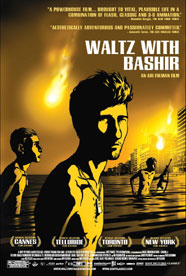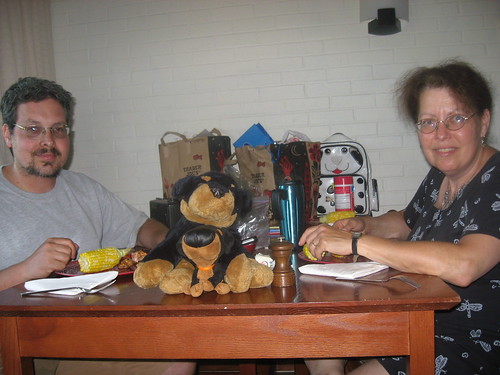|
|
Wednesday, December third, 2008
Saramago writes a quick note to say that a new book has started walking around in his head. ¡Uff!
posted evening of December third, 2008: Respond
➳ More posts about Saramago's Notebook
|  |
|
 This movie will be opening in the city at the end of this month. It looks like a really disturbing and meaningful look at conflict in the Middle East (or one subset of such conflict) -- it is a documentary/animated recreation of the massacre at Sabra and Shatila, directed by a man who participated in that massacre as a 19-year-old Israeli Defense Forces soldier. Sebastian, who saw it in Germany, describes it as "devastating." This movie will be opening in the city at the end of this month. It looks like a really disturbing and meaningful look at conflict in the Middle East (or one subset of such conflict) -- it is a documentary/animated recreation of the massacre at Sabra and Shatila, directed by a man who participated in that massacre as a 19-year-old Israeli Defense Forces soldier. Sebastian, who saw it in Germany, describes it as "devastating."
Jonathan Freedman reviews the film for the Guardian; he calls it "startlingly original" and says, "The effect should be flat, but the low-tech style somehow conveys an emotional depth that catches you by surprise. The characters appear in two dimensions, yet are intensely human." Folman explains to Freedman why he chose animation to create his documentary: "There was no other way to do it, to show memories, hallucinations, dreams. War is like a really bad acid trip, and this was the only way to show that."
posted morning of December third, 2008: Respond
➳ More posts about Waltz with Bashir
|  |
Tuesday, December second, 2008
 Thanks to graffiti artist GRL, I just found out about this color. Hee! (As long as we're thinking about dirty shades of green, check out the new game: if you like Tetris and Bloxxorz, you'll love Assembler. The site will sometimes crash your browser, though.)  (Source code for this kind of a look is, e.g., <div style="background-color:#bada55;">...</div>)
posted morning of December second, 2008: Respond
|  |
Monday, December first, 2008
 From Dark Roasted Blend, a page of truly spectacular microscope photography. There are even images with visibly granular atoms, which I did not know was possible.* The pictures are selected from among the winners and honorable mentions of this year's BioScapes Digital Imaging Competition, and other sources. (via Apostropher.) From Dark Roasted Blend, a page of truly spectacular microscope photography. There are even images with visibly granular atoms, which I did not know was possible.* The pictures are selected from among the winners and honorable mentions of this year's BioScapes Digital Imaging Competition, and other sources. (via Apostropher.)
 * Yep: you need a scanning tunneling microscope to do it. Atoms have been being photographed since before I was born.
posted evening of December first, 2008: Respond
➳ More posts about Pretty Pictures
|  |
|
I was looking back over the past year of posts I've written about reading, to see what I've been thinking about this year; it looks like 2008 can be aptly dubbed "the year Jeremy fell in love with Saramago." The great majority of my reading posts this year have been about Blindness, Seeing, The Cave, The Year of the Death of Ricardo Reis, Death with Interruptions and Saramago's Notebook. And he has several more novels waiting for me to write about them in 2009! (Two other books I posted a fair amount about this year, The Passionate War and Fortunata and Jacinta, were both begun as part of a quest to understand Iberian history and literature, which quest has its roots in wanting to understand Saramago. And Saramago was partly responsible for making me want to reread Borges.) I read a lot of Pamuk this year as well -- the author whom I spent 2007 falling in love with. The Black Book was a really rewarding, engaging novel; and McGaha's Autobiographies of Orhan Pamuk provided some useful context for Pamuk's novels. I'm keeping an eye out for new writing by and about Pamuk, to keep my bibliography up-to-date. I also reread Inferno in a (possibly misguided) effort to find historical background relevant to Pamuk's work. And I thank Pamuk for getting me interested in the history of the Armenian genocide, inspiring me to read Çetin's My Grandmother. And what else? I enjoyed The Golden Compass hugely, and am looking forward to reading the rest of Pullman's work. Never Let Me Go is a beautiful novel. In Hovering Flight is a really promising first novel. Nixonland clued me in to the political scene around the time of my birth, in a much more detailed, careful way than I have ever understood them before. I did not write about it at all, but I quite enjoyed Annie Proulx' Fine Just the Way It Is. It was nice rereading Huckleberry Finn with Sylvia. Too early for a post summing up the year? Perhaps. But it just seems like the right time for it. I'm looking forward to the new reading I'll do next year.
posted evening of December first, 2008: Respond
➳ More posts about Tsundoku
|  |
|
My review of Saramago's Death with Interruptions is published in the December issue of Scott Esposito's literary journal, The Quarterly Conversation. Happy! I like having written an article and developed it to the point of publishability. Looking at it I see some minor quibbles with wording, edits I'd like to make; but it's done! It's also not a rave review -- fairly negative indeed -- which gives me a sort of perverse pleasure. Like I'm glad to see I was able to write something other than a glowing review of Saramago, like it validates my having a critical eye, that I'm able to point out the faults of this book, and lends a kind of credibility to any rave reviews I write in the future. Which, well, time to go read some new books and look for a subject!
posted afternoon of December first, 2008: Respond
➳ More posts about Writing Projects
|  |
Sunday, November 30th, 2008
 Saramago writes today about the Livraria Cultura, a giant bookstore in the Conjunto Nacional shopping mall in São Paulo. (He and Pilar have been travelling in Brazil for the last few weeks and are now returning to the Canary Islands.) Saramago writes today about the Livraria Cultura, a giant bookstore in the Conjunto Nacional shopping mall in São Paulo. (He and Pilar have been travelling in Brazil for the last few weeks and are now returning to the Canary Islands.)
The last image that we bring with us from Brazil is of a beautiful bookstore, a cathedral of books, modern, efficient, lovely. It is Livraria Cultura, in the Conjunto Nacional. It is a bookstore to be sure, a place for buying books, but it is also a place for enjoying the impressive spectacle of so many titles organized in such an attractive form, as if it were not a store, as if we were speaking of a work of art. The Livraria Cultura is a work of art. So: kind of funny and cute to think about old man Saramago digging the lovely new bookstore. Especially nice to think about that, when I've got in mind pictures of young Pamuk seeking out books in the antiquarian shops of Istanbul.
posted evening of November 30th, 2008: Respond
➳ More posts about José Saramago
|  |
The Borgesian library is not for me a metaphysical fantasy of an infinite worldâ??it is the library I have built up in my house in Istanbul, volume by volume. Pamuk's new memoir in the New York Review of Books is about building up his library -- one book at a time, "a bit like building a house stone by stone." It's similar to the shorter piece he published last month in the Guardian but contains some valuable new information.Turkey was never a Western colony, and so when Turks imitated the West as Atatürk decreed, it was never the damning, demeaning undertaking described by Kundera, Naipaul, and Edward Saidâ??it became an important part of Turkish identity. I hadn't quite gotten this previously -- it is easier to understand his presentation of the conflict between Islamist and Nationalist in Snow, with this point in hand.
When I decided to become a writer, neither poems nor novels were valued as individual expressions of an artistic sensibility, a strange spirit, a soul: the dominant view was that serious writers worked collectively, and their work was valued for the way in which it contributed to a social utopia and reflected a shared vision (like modernism, socialism, Islamism, nationalism, or secular republicanism). There was little interest in literary circles in the problem of the individual creative writer who drew from history and tradition, or who tried to find the literary form that best accommodated his voice. I'm really taken with the idea of Pamuk as working to introduce the notion of the author as "individual creative writer" into a Turkish literary scene which values the author as a member of an ideological collective.
 (One annoying thing: The NYRB software that turns magazine articles into web pages has a problem with some Turkish characters, in particular at least ı and ğ, which it has replaced with blank spaces.) Update: Scott Esposito is unhappy to see this essay appearing in NYRB so soon after a version was published in the Guardian -- I can see his point although I like the piece a lot better than he does.
posted evening of November 30th, 2008: Respond
➳ More posts about Orhan Pamuk
|  |
|
 Some beautiful art at this Flicker set of images from the recent Urban Painting exhibition in Carugate, Italy. (via Wooster Collective) Some beautiful art at this Flicker set of images from the recent Urban Painting exhibition in Carugate, Italy. (via Wooster Collective)
posted evening of November 30th, 2008: Respond
|  |
|
The first chapter of The Stone Raft is pretty dreamy. Saramago has got me wondering though, with his silent dogs of Cerbère, whose barking will herald the end of the world -- this seems like a weird detail to invent, but I'm not finding any reference to it with Google. I want to know if this is a real folk tale or a creation of Saramago's. And a couple of things to do with translation: what is referenced by "And to all appearances definitive," at the beginning of the last sentence of the long paragraph on pp 2-3? There is no obvious subject for the modifier. And on page 1, "a dog with three heads and the above-mentioned named of Cerberus," ("named" clearly a typo for "name") makes me do a double-take -- the name Cerberus has not been mentioned, although the French form of that name is Cerbère, the same as (though etymologically unrelated to) the village where the dogs are barking. Is Saramago counting on the reader to know this? Or is the Portuguese form of Cerberus the same as the French?... This chapter consists mainly of introducing some characters by name and discussing what they were doing at a particular moment in time, the moment (as I know from reading the blurb on the back cover*) when Iberia breaks away from the continent of Europe. It is cute and whimsical -- but there are some passages that pull the reader below the surface to look at the underpinnings of the structure that this novel will build. José Anaiço is walking through a field at the fateful moment, when a flock of starlings rises into the sky and wheels around.
...birds don't have reasons, just instincts, often vague and involuntary as if they were not part of us, we spoke about instincts, but also about reasons and motives. So let us not ask José Anaiço who he is and what he does for a living, where he comes from and where he is going, whatever we find out about him, we shall only find out from him, and this description, this sketchy information will have to serve for Joana Carda and her elm branch, for Joaquim Sassa and the stone he threw into the sea, for Pedro Orce and the chair he got up from, life does not begin when people are born, if it were so, each day would be a day gained, life begins much later, and how often too late, not to mention those lives that have no sooner begun than they are over, which has led one poet to exclaim, Ah, who will write the history of what might have been.
(And what poet was that? Google gives no results except from this book. Perhaps an invention of Saramago's, perhaps something that has not yet been translated to English in this precise wording.)A beautiful passage a few pages before this one is the first point where Saramago addresses the audience, asks us to consider what we are doing when we sit down and start reading the story he has composed:
Writing is extremely difficult, it is an enormous responsibility, you need only think of the exhausting work involved in setting out events in chronological order, first this one, then that, or, if more conducive to the desired effect, today's event before yesterday's episode, and other no less risky acrobatics, presenting the past as if it were something new, or the present as a continuous process with neither beginning nor end, but, however hard writers might try, there is one feat they cannot achieve, and that is to put into writing, in the same tense, two events that have occurred simultaneously,... The people who come off best are the opera singers, each with his or her own part to sing, three, four, five, six in all among the tenors, basses, sopranos and baritones, all singing different words, the cynic mocking, the ingénue pleading, the gallant lover slow in coming to her aid, what interests the operagoer is the music, but the reader is not like this, he wants everything explained, syllable by syllable, one after the other, as they are shown here.
And I think oh gosh, this beautiful prose! It washes pleasantly over me but gets even better when I pause and examine it more closely. The rhythm of phrases and commas and repetitions and the power of the period.
 * A mildly funny thing about the blurb: it was written in ’96 and says Saramago is "Winner of the prestigious Independent Foreign Fiction Prize" -- I'm used to thinking of Saramago as the winner of the prestigious Nobel prize for literature but of course he was not always that.
posted morning of November 30th, 2008: 2 responses
➳ More posts about The Stone Raft
| Previous posts
Archives  | |
|
Drop me a line! or, sign my Guestbook.
•
Check out Ellen's writing at Patch.com.
| |


















